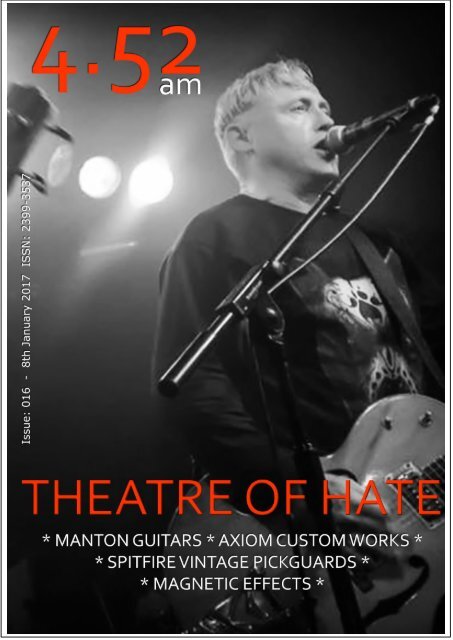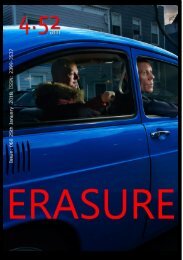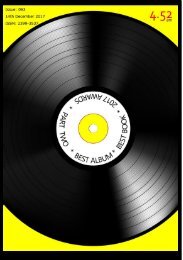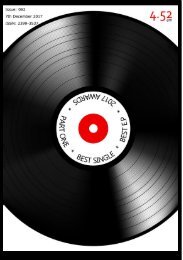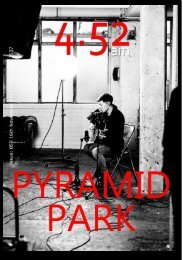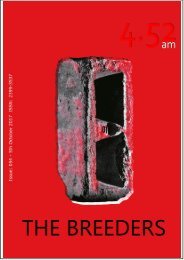4.52am Issue: 016 - 8th January 2017
Your Free Weekly Guitar and Alternative Music Magazine from Guitar Quarterly
Your Free Weekly Guitar and Alternative Music Magazine from Guitar Quarterly
You also want an ePaper? Increase the reach of your titles
YUMPU automatically turns print PDFs into web optimized ePapers that Google loves.
theFretBoard is a forum for guitarists, and the occasional bassist.<br />
It’s run by guitarists, for guitarists, and covers just about all the “stuff” that interests<br />
guitarists, including guitars (!), amps, fx, learning, playing, buying, selling and anything<br />
else that comes to the minds of thousands of guitarists every day.<br />
It’s completely free to read and free to join – membership allows readers to see<br />
additional areas of the forum which aren’t visible to non-members, to start their own<br />
discussions and post their own comments.<br />
Best of all, there are NO ADVERTS.<br />
Join the UK’s busiest, most interesting and most diverse guitar related forum for free<br />
(did we mention that it’s free?) at theFretBoard.co.uk.<br />
Now.<br />
Why not pay us a visit, and check:<br />
The Threads of the week, click if you dare:<br />
1. Show Us Your Rare and Unusual Guitars<br />
2. So, How Many Guitars Do You Actually Own?
<strong>2017</strong>, then<br />
Welcome to our first issue of <strong>4.52am</strong> in <strong>2017</strong>,<br />
and I’ll ask you to forgive the frazzled look, but<br />
we have been running around trying to get the<br />
first Guitar Quarterly together too, a mixture of<br />
pleasure and pain.<br />
This week, we have the brilliant Theatre of<br />
Hate and a look back at what became of the<br />
Westworld.<br />
On the guitar front, we have a bumper crop<br />
with a first look at something heavy from<br />
Manton Guitars, who are doing some special<br />
things, something old and something new from<br />
the always cool Magnetic Effects, an update<br />
from Spitfire Vintage Pickguards on our Elvis<br />
Costello ‘Homage’, and some fantastic news<br />
for those of you that have bought a Squier VI<br />
and would like some reasonably priced strings<br />
that don’t hang elastic-like, with a chat with<br />
Axion Custom Works.<br />
Oh, and no music reviews this week as we are<br />
revamping things next week and we thought it<br />
would be worth the wait…<br />
Hope you enjoy it…<br />
All at <strong>4.52am</strong>
CONTENTS<br />
FEATURES<br />
Theatre of Hate<br />
Whatever Happened to the Westworld?<br />
Manton Customs<br />
Matriarch 8 String<br />
Axion Custom Works<br />
Bass VI Strings and then some<br />
Spitfire Vintage Pickguards<br />
Tort Law For Elvis<br />
Magnetic Effects<br />
Zola & Electrochop
FEATURES
THEATRE OF HATE<br />
Whatever Happened to the Westworld?<br />
I never got to see Theatre of Hate during<br />
the two years that should have been their<br />
glory days, in fact I never got to see Kirk<br />
Brandon at all until much later, fronting<br />
Spear of Destiny in a Hockey Stadium<br />
somewhere in Milton Keynes. It doesn’t<br />
get more New Wave Punk than that, let’s<br />
face it.<br />
Although whilst I loved Spear of Destiny,<br />
I never feel that you can beat what an<br />
artist’s first real band is doing as like<br />
authors and painters, first time around<br />
you get their art in the purest form,<br />
before the real world gets in the way.<br />
With novels you often get them of the<br />
kitchen sink variety where every possible<br />
plot twist and detail is included that has<br />
ever popped up in the author’s brain, and<br />
it is the same with bands and song<br />
writers, it is why there are so many onehitters<br />
out there.<br />
All of which I couldn’t help but think of<br />
when I got the rather brilliant compilation<br />
of Theatre of Hate from those cool chaps<br />
at Cherry Red Records. As they do so<br />
often they have taken something<br />
shortlived but special, and gathered all<br />
the parts that maybe dropped to the side<br />
– live performances, demos, unreleased<br />
tracks – and opulently packaged it for<br />
my delectation. (OK, anybody that<br />
wants it, not just me, but you know.<br />
I’m nothing if not ego-laden.)<br />
Listening to the band now, I have to<br />
say I really can’t understand how it did<br />
go wrong, but like many before them<br />
and since, a little bad luck here and a<br />
bad break there was enough to change<br />
what should have been into another<br />
tale of woe.<br />
The story started earlier of course, but<br />
the first time I remember seeing ToH<br />
was on Top of the pops. It was the only<br />
place you used to see any band of<br />
course, but I can vividly remember the<br />
strutting, spitting rockabilly punks with<br />
the monotonous beats and screaming<br />
guitars, they were like nothing else<br />
around and totally fascinating. Then<br />
there was the saxophone. Man, it was<br />
definitely a good time for music and I<br />
can’t help but wonder how all those sax<br />
players have eaten over the decades<br />
since.<br />
The single that day was of course their<br />
only real hit ‘Do You Believe In The<br />
Westworld’, and the thumping drums
soon had me with my nose against the<br />
glass of the 14” screen.<br />
I loved the twanging of the guitars, I<br />
think that was the first thing that hit me,<br />
the thumping noise I’d associated with<br />
my Dad’s Duane Eddy and Eddie<br />
Cochran LPs, but this was much more<br />
vibrant and strident. In fact I think it was<br />
the first time that I really got the feeling<br />
you can get between your ears from the<br />
repetition of a beat, the mechanical<br />
thudding rhythm that just wouldn’t let<br />
you go.<br />
It wasn’t just me of course, the country<br />
was instantly full of ‘younger viewers’<br />
who suddenly had seen something<br />
different, something important, even if<br />
we didn’t quite understand why.<br />
Unsurprisingly, the next weekend saw<br />
the single shooting into the Top 40, and<br />
their destiny as the heirs apparent to the<br />
Clash seemed assured.<br />
Unsurprisingly, looking back, it was a<br />
more familiar story at this point as of<br />
course, indie music in Britain then<br />
always seemed to find a way to mess it<br />
up, and for ToH it was to be no different.<br />
Brandon explains what went wrong,<br />
“Rough Trade distributed the single. It<br />
got to 50,000 sales and our manager<br />
Terry Razor said ‘Press another 50,000<br />
copies’ but they said ‘No.’ So it dropped<br />
down the chart. Then Stiff took it up and<br />
it sold another 50,000 to 100,000 copies<br />
– to this day no one knows exactly how<br />
many it sold. If sales were consistent, it<br />
could have made the Top 5, even Number<br />
1. No one who ever heard that record<br />
could forget it.”<br />
This was obviously a disappointment, but<br />
the album was ready to go and hit the<br />
heights of number 32.<br />
Listening to it now, the depth of the<br />
songs was stunning, and whilst they were<br />
corralled with Killing Joke or Joy Division<br />
at the time, there was a different feel to<br />
the songs than that, edging more toward<br />
the Cure or the Clash themselves.<br />
In a lot of ways having Mick Jones<br />
produce the album probably did them few<br />
favours, and it is only looking back that<br />
you can perhaps see that his later work<br />
with Big Audio Dynamite owed something<br />
to the writing of Brandon. ToH supporting<br />
the Clash didn’t help either although<br />
nobody was about to turn it down.<br />
Stan Stammers explained how Jones got<br />
involved with the band,<br />
“I knew Mick quite well already from my<br />
time following the Clash around and was<br />
stoked when I was told he’d be producing<br />
us.” Brandon interjects,<br />
“I remember Theatre of Hate playing The<br />
Venue in Victoria. Mick Jones was<br />
standing on his own in this big line of<br />
people. I walked up to him and said<br />
“What you doing?” He goes, ‘Waiting to<br />
see a band.’ I went “OK, well come with<br />
us then.” Whether he knew we were the<br />
band or not, I’m not sure. Barring the first<br />
single, he produced all of it.”
The band couldn’t believe their luck and<br />
working with Jones was an eye-opener,<br />
for Stammers,<br />
“The whole Westworld session was an<br />
education. We did the backing tracks at<br />
Redan Recorders in Westbourne Grove<br />
then the overdubs and mixing at<br />
Wessex. It was all done at night. Mick<br />
flew in from the States and had to return<br />
after to do Clash stuff, so he wanted to<br />
stay on American time to avoid getting<br />
too messed up. I just thought he didn’t<br />
want to get up too early! We’d been<br />
playing these songs for a year and knew<br />
them back to front, they went down<br />
really easy.”<br />
John-Boy Lennard agrees,<br />
“Everything was experimental. At 3am<br />
one morning Mick brought in a clarinet.<br />
I told him I had never played one before.<br />
At 6am I was playing my first clarinet<br />
solo. I created other sounds – not<br />
playing the sax but recording just the<br />
sound of the key pads. It was great<br />
being so experimental with an energy<br />
that Mick brought to the table.”<br />
Kirk joins in,<br />
“My voice was basically one-take stuff.<br />
The Clash had recorded an album at<br />
Wessex not that long before, and Jerry<br />
Green said ‘Right, we’ll set you up like<br />
we did Joe (Strummer.)’ So he set me up<br />
in front of the glass of the control room.<br />
He used a Neumann and you get a<br />
reflection straight off the glass going<br />
back to the microphone, so that’s how we<br />
did it.”<br />
The result of which was this other worldly<br />
vocal that defines Brandon’s sound even<br />
today.<br />
Stammer expands,<br />
“Mick had ideas that no-one else was<br />
doing and his chemistry with the band<br />
and understanding of what we were<br />
trying to do was the key to its success.”<br />
Brandon had to work hard to get Jones to<br />
add some of his guitar playing to the<br />
record,<br />
“Mick didn’t want to play on the album,<br />
saying ‘It’s your record, it’s not for me to<br />
play on’, then I persuaded him – ‘Mick<br />
bring in a Les Paul and just do<br />
something.’ The following day he brought<br />
in one of his Les Paul Customs and he<br />
doubled up what I played on ‘Do You<br />
Believe In The Westworld.’ Mick played it<br />
so much better than I do. It was brilliant,<br />
absolutely brilliant.”<br />
The magic didn’t end there though, as<br />
Brandon clarifies,<br />
“When we came to mix it, Mick had all the<br />
delays and reverbs set up and obviously<br />
in those days it was just tape going into<br />
the desk. Mick would jump on it, be<br />
playing it and banging things on and off.<br />
Jeremy Green was the engineer; he was<br />
there with Chris Thomas and Bill Price<br />
doing Never Mind The Bollocks, he’d<br />
worked on Clash albums. To be there was<br />
thrilling. We were making this up as we<br />
went along.”
Check out the Deluxe Edition HERE
Jones soon had the album finished, but<br />
he hadn’t gone for a straight forward<br />
reflection of the band’s full on Rock of<br />
the live shows, deciding instead to look<br />
deeper at the darkness that was within<br />
the music. There were elements of dub<br />
that again you later found on Big Audio<br />
Dynamite, and a real dark and haunting<br />
treatment of the saxophone through the<br />
album. It was something that genuinely<br />
hadn’t been heard before.<br />
As Brandon concluded,<br />
“The music wasn’t up, but there was still<br />
an incredible buzz about it. Mick wanted<br />
to make an album that stood apart from<br />
is age.”<br />
From this point on, the band constantly<br />
changed until it imploded just months<br />
later.<br />
Booked for the support spot with the<br />
Clash and then their own tour, Billy Duffy<br />
joined the band as a second guitarist.<br />
Duffy quite literally gave up his job,<br />
bought a Gretsch White Falcon and got<br />
his first passport before disappearing off<br />
around the world, and appearing on Top<br />
of the Pops. Brandon remembers how he<br />
was recruited,<br />
“I met Billy Duffy at the Whisky a Go-Go<br />
in Wardour Street. I said I needed a<br />
guitar player and he said ‘I play guitar.’<br />
So I said, ‘Come down to the Sunday<br />
School.’ He did, it was great, we clicked<br />
immediately, he was a smart guy.”<br />
Stammers saw the changes though, as<br />
not only Duffy joined the band but<br />
drummer Rendell was also replaced by<br />
Nigel Preston.<br />
“It was different with Billy and Nigel, but<br />
the band continued to get bigger. They<br />
did fit in, but I think we lost some of the<br />
space and feel we used to create. Lots of<br />
tom-tom bashing and wailing guitars, it<br />
was still great just a different vibe.”<br />
Brandon agreed,<br />
“When Nigel joined it felt different. Not in<br />
a good or bad way, just different. Nigel<br />
was an incredible drummer and a really<br />
funny guy, a great laugh.”<br />
Lennard could see the changes they<br />
brought,<br />
“Billy was great and brought a good rock<br />
‘n’ roll vibe to the band. Nigel was a<br />
strong drummer, but like any new<br />
musician it brings a new direction. Luke<br />
was Theatre of Hate and Nigel was<br />
Nigel.”<br />
Of course by the sessions for the second<br />
album, the band had fallen apart.<br />
Brandon looks back on the debut as a<br />
triumph though,<br />
“With Westworld people expected it to be<br />
really loud and angry. But Mick captured<br />
the essence of the songs without the fullon<br />
total fury that used to go on onstage.<br />
He said, ‘This is like a statement of who<br />
you actually are – these songs that you’ve<br />
written, and where the band is today.’ He<br />
had an overview-perspective, he’d been<br />
there and back long before I got the band<br />
together. That’s what helped make it<br />
what it was.”
Do You Believe?
Theatre of Hate
MANTON CUSTOMS<br />
Matriarch 8 String<br />
Lord knows I love a bit of flamed maple<br />
as much as the next chap-who-isn’t-thatkeen-on-posh-guitars,<br />
and I can even<br />
just about put up with a bit of quilt too.<br />
In small doses.<br />
When it comes to good old fashioned<br />
wood grain, especially ash or walnut or<br />
rosewood, well, I’m your man, and then<br />
of course you can’t go too far wrong with<br />
Du Pont’s finest either. Or Paisley.<br />
Saying all of that though, sometimes and<br />
on some guitars I can’t help but feel that<br />
it would be nice if one or two of our uber<br />
talented luthier chaps stepped away from<br />
their book-matching-manuals, and just<br />
painted the bloody things black.<br />
I mean, it is playing them not looking at<br />
the we’re really bothered about, isn’t it?<br />
So I practically got all Pope JP2 and<br />
kissed the ground when I happened<br />
across Manton Guitars, recently, and<br />
snapped up an interview with Mr Robin<br />
Manton himself which will be appearing<br />
in the first Guitar Quarterly.<br />
As is my wont though, I thought that we<br />
could look at a couple of the models he<br />
produces under the moniker of Manton<br />
Guitars over the next couple of weeks,<br />
with this week’s starter for ten being<br />
the rather stunningly cool Matriarch 8<br />
String.<br />
Why the Matriarch? Well, clearly it is<br />
because it is the Mother of all Strats,<br />
and looking at the spec I really don’t<br />
see how anybody could argue.<br />
From the top it is an 8 string guitar –<br />
something I’ve only recently got<br />
interested in, I hate to admit, and one<br />
that I think will appeal to a lot of<br />
people. Manton are (they believe and I<br />
do too) the only UK luthier to offer their<br />
guitars built using the True<br />
Temperament Fretting System. If you<br />
haven’t come across this before, the<br />
first thing you will notice is that the<br />
frets are, as my daughter described, all<br />
‘wiggly’. The second thing you will<br />
notice is that every single note on the<br />
fretboard sounds bell clear, has a<br />
beautiful resonance and sustains way<br />
beyond what you would normally<br />
expect. I won’t get into the thinking<br />
behind it here (not least because we<br />
are looking deeper at that in GQ but it<br />
is a fantastic thing for Manton to be<br />
doing and when you look into what it<br />
entails, it is a level of accuracy and skill<br />
way beyond traditional luthiery.
There is more to the Matriarch than its<br />
intonation though, and as with all of<br />
their guitars on this Manton have been<br />
especially careful about the wood<br />
selection with the guitar boasting a top<br />
quality Mahogany Body, along with a<br />
Thick AAA Carved Spruce top. The neck<br />
receives special attention of course,<br />
having a five-piece Maple and Black<br />
Walnut construction along with the AAA<br />
Grade Ebony Fingerboard.<br />
Despite my liking for the simplicity of the<br />
colour scheme, there is of course a few<br />
aesthetic flourishes, a Matching Spruce<br />
Head Plate, and a quite large and<br />
opulent Mother of Pearl inlay toward the<br />
headstock that certainly catches your<br />
eye.<br />
The design of the guitar itself takes<br />
many notes from that of a cello and it is<br />
a quite beautiful construction to see.<br />
This Matriarch was actually a custom job<br />
for Vortigern from the Avant-guarde<br />
Metal band Lychgate, who wanted an 8<br />
String with 27” scale. As Robin explains,<br />
“All music in the band is written on piano<br />
first and then transcribed to guitar. On<br />
recording the album 'An Antidote for the<br />
Glass Pill' the tracks were performed on<br />
pipe organ and accompanied by the<br />
band. Due to the organ vs. guitar<br />
combination, it is said that the tuning<br />
and intonation issues of a normal guitar<br />
were occasionally cause for a headache<br />
during the recording sessions. So, as a<br />
way forward, not only will the true<br />
temperament guitar remove these<br />
issues, but also expand the octave range<br />
of the guitar in order that there will be<br />
greater flexibility during transcriptions<br />
from keyboard to guitar.”<br />
Vortigern was more than pleased with the<br />
guitar,<br />
"It was almost surreal to finally play a<br />
guitar with such accurate intonation<br />
everywhere on the fretboard. I would<br />
press a key on my keyboard and find the<br />
corresponding note on the guitar, and<br />
find a very pleasing-to-the-ear<br />
relationship. There was no more tuning<br />
oscillation to be heard in the third "G"<br />
string (as is the case with most guitars)<br />
and no buzz anywhere on the fretboard;<br />
even on the first fret, bottom string. The<br />
action is exactly as I like it and I think we<br />
also couldn't have chosen our string<br />
gauge any better.<br />
Working with Manton Customs has been<br />
a positive experience from start to finish.<br />
Nothing was ever too much trouble and<br />
all my concerns at every step of the<br />
building process were answered by the<br />
kind of luthier that really knows his job.<br />
This guitar is the model I have waited for<br />
in the back of my mind for a very long<br />
time, and it is truly given me back the<br />
passion and inspiration that I need. I'm<br />
now looking forward to pushing myself as<br />
a musician to the next level with a truly<br />
reliable and greatly engineered<br />
instrument."<br />
Next week we will be taking a look at<br />
another of Robin’s guitars, but in the<br />
meantime you really should go and check<br />
them out HERE.
AXION CUSTOM WORKS<br />
Bass VI Strings and then some<br />
One of the things that Fender have done<br />
well in recent times, is to finally get their<br />
act together and re-issue some guitars<br />
that aren’t Strats or Teles. It has taken<br />
decades, but good on them. Jazzmasters<br />
and Jaguars were the opening salvo, and<br />
they followed it up with something I<br />
never thought I’d see in the shape of<br />
Starcasters and Coronados (and folks, if<br />
you are reading, an Electric XII is long<br />
overdue), but one that they got exactly<br />
right was the rebirth of the Bass VI.<br />
Now, OK, there may have been the odd<br />
baritone before, but the Fender Bass VI<br />
they released as part of their Pawn Shop<br />
imagining was cool, but for me the Squier<br />
VI whilst being cheaper, was closer to the<br />
real deal and definitely the one to get.<br />
In fact the only thing they seem to have<br />
struggled with was the strings and<br />
everybody I know who has a VI has had<br />
to bite the bullet and pay through the<br />
nose for some to make it sound anything<br />
at all.<br />
Imagine how chuffed I was then to hear<br />
that not only had somebody got it<br />
together to produce a set of top quality<br />
strings for a ridiculously cheap price that<br />
isn’t much more than a bog standard set<br />
of Elixirs, but to then find out they were<br />
being made in the UK, well, blimey. I<br />
had to find out more. And so I caught<br />
up with Glen Havelock the chap in<br />
question, of Axion Custom Works, who<br />
explained how he happened to become<br />
the go to guy for VI Strings.<br />
Glen explained,<br />
“I spend a couple of days a week doing<br />
guitar repairs and tech work at a<br />
Fender dealer in Manchester, so a few<br />
years ago when there was a revival of<br />
interest in the Bass VI with a couple of<br />
reissues, I immediately found a couple<br />
of problems with the instruments when<br />
asked to set them up. The bridge issues<br />
I could sort out by modifying the<br />
intonations screws, and it has since<br />
been addressed more thoroughly by<br />
StayTrem among others. But the<br />
horrible slackness of the A and<br />
especially low E strings made setups at<br />
a sensible playable string height just<br />
about impossible. The low E, with stock<br />
strings and set up to 2.5 or even 3mm<br />
at the 12th fret, has fret rattle along<br />
the whole fingerboard length and<br />
sounds like a slightly metallic rubber<br />
band.
So, I wondered, how about just<br />
replacing those two strings? Well it is not<br />
as easy as you think. Firstly, it is short<br />
scale but with a long run to the tailpiece.<br />
Effectively this means you need the least<br />
common bass scale strings, 32" (usually<br />
referred to as "medium scale"). Long<br />
scale 34" strings won't work, because<br />
Bass VIs have vintage Strat style<br />
machine heads, so you can barely get<br />
the string through the split, never mind<br />
down the hole, so they need to have a<br />
taper at just the right point. The other<br />
issue is that big bad bass ball ends<br />
struggle to fit under the tailpiece, and<br />
can interfere with the trem action (not<br />
that it is great anyway). So they need<br />
smaller, almost guitar string sized ball<br />
ends.<br />
Hofner make a string set for their reissue<br />
violin bass on which the E and A strings<br />
are just about perfect, apart from having<br />
a green silk wrap and costing over £30 a<br />
set (singles not available!) But there was<br />
pretty much nothing on the market that<br />
was right for the Bass VI until LaBella<br />
introduced their range, which sadly<br />
begins at around £50 a set at UK street<br />
prices.<br />
I realised I needed to find an alternative<br />
and I had been getting speciality strings<br />
for the shop from Newtone in<br />
Derbyshire, they make all sorts and have<br />
a great reputation for making odd gauge<br />
sets for acoustics when people play in<br />
fairly extreme open tunings, usually for<br />
the folky crowd. I remembered reading<br />
something about Newtone making<br />
custom sets for Peter Hook to go on both<br />
his Bass VI and his Shergold Marathon 6.<br />
So I got in touch with the very<br />
approachable Neil Silverman to see if we<br />
could do something. I went through a few<br />
iterations of string specs and testing<br />
before finally settling on a set that was,<br />
for the first four courses, pretty similar to<br />
the stock strings, but with a heavier A<br />
(0.080") and a much heavier low E<br />
(0.100").<br />
One secret of this set is that some strings<br />
have a thicker than standard core, to try<br />
and maintain an even tension<br />
throughout, so they feel and sound alike<br />
and can achieve a good working setup.<br />
They are nickel plated steel, roundwounds,<br />
but there may well be some<br />
other varieties later on.<br />
Neil shipped me the first production batch<br />
about a month ago, and while I was<br />
trying to get all the marketing ducks in a<br />
line, Marc Ransley from Mojo Pickups<br />
(and a complete offset and Bass VI nut)<br />
tried a set out and gave me an<br />
unexpectedly busy Sunday - he raved<br />
about them on Instagram and I was<br />
suddenly swamped with enquiries before<br />
I was really ready to go.<br />
I’ve just launched them officially on the<br />
Axion web site (HERE) so people can<br />
order them now – they are a similar price<br />
to a lot of the alternatives – apart from<br />
La Bella obviously, but they work a lot<br />
better.”
You really can’t underrate just how big a<br />
step these strings are, but I couldn’t help<br />
notice some of the other things Glen<br />
offers us guitar modders, and more to<br />
the point his willingness to manufacture<br />
one-off parts.<br />
For example, I have to say that I love<br />
the copper scratchplate he has made to<br />
house a couple of Mojo Pickups’ Gold<br />
Foils, which is just beautiful. I remember<br />
making myself a much simpler one a few<br />
years ago (I still have the scars) so I can<br />
appreciate how ‘good’ that makes him.<br />
But then I noticed the incredibly<br />
beautiful black Perspex Strat<br />
scratchplate inspired by a certain Mr<br />
Gilmour and something designed to<br />
again work with a couple of Mojo Pickups<br />
fantastic pickups in the shape of their lap<br />
Steel and Gold Foil pickups.<br />
For me though the really impressive thing<br />
about Glen and Axion in particular, are his<br />
willingness to create parts as one-offs or<br />
that are otherwise unavailable.<br />
A great example of this are some of the<br />
pickup rings he has created (not least<br />
because I have a guitar that needs<br />
something along these lines very soon),<br />
and I have to say I love the look of the<br />
‘Goof Rings’ he has already put together<br />
for people.<br />
All in all, Axion are a lot more than your<br />
standard guitar repair or set-up<br />
emporium, and they will certainly be top<br />
of my list for more than just strings. Go<br />
check them out HERE and if you have a<br />
VI you seriously have to try these strings.
SPITFIRE VINTAGE PICKGUARDS<br />
Tort Law For Elvis<br />
In case you somehow missed it before<br />
Christmas, having had a look at the rather<br />
beautiful Fender Elvis Costello Jazzmaster<br />
guitar, we thought it would be many<br />
kinds of wonderful to pay homage to it,<br />
and the man himself, by putting together<br />
a Jazzmaster that vaguely matched the<br />
looks, but using the best of the 21 st<br />
Century guitar parts we could lay our<br />
hands on.<br />
It would be a good chance to see what<br />
was out there and compare them to what<br />
you can buy off-the-shelf, as it were.<br />
Over the coming weeks then, we’ll look at<br />
all manner of things, but if I had speed<br />
dial (or actually knew what it was), top of<br />
my list would have been Mark Townsend,<br />
and it was him I talked to, as his company<br />
Spitfire Vintage Tortoiseshell Pickguards<br />
(and breathe) makes what are quite<br />
simply put the very best, most beautiful<br />
Tortie scratchplates known to mankind.<br />
Now I’ve mentioned before that Mark was<br />
up for the challenge, and I may be dumb<br />
(I am most definitely qualified for that)<br />
but one thing I know is that if you find an<br />
artist, or you find somebody who knows<br />
their stuff and to my mind Mark is both of<br />
those – you let them get on with it.<br />
I previously showed the list of options<br />
I had chosen, but when it came down<br />
to it I did something bright and just told<br />
him to do something special, to create<br />
something that he thought would be<br />
right.<br />
Needless to say he did just that.<br />
There really isn’t too much to say, as<br />
the photos tell the story far better than<br />
I could, but I wanted to start with the<br />
one to the left as it showed what it is<br />
that so many people making printed<br />
‘Tortoiseshell’ scratchplates get wrong.<br />
The key is pretty clear, you create a<br />
beautiful top layer and meld this to<br />
three layers, white-black-white below<br />
it.<br />
Mark of course will age ours as you’ll<br />
see and obviously cut it to shape and<br />
include the pickups, pot and switch<br />
routings too.<br />
I’ll say no more though, just have a<br />
look at the pretty pictures and enjoy.<br />
Hopefully next week I’ll show you it<br />
nailed on the body…<br />
As before, check out Spitfire HERE
MAGNETIC EFFECTS<br />
Zola & Electrochop<br />
I think everybody that plays guitar needs<br />
a certain few pedals, and let’s face it<br />
without a good clean boost you are<br />
halfway stuffed. OK, a new clean boost<br />
may not be the most exciting news in<br />
pedal-land, but when you consider just<br />
how much oompth Magnetic Effects’ new<br />
Zola gives you, it is probably time to sit up<br />
straight and get serious.<br />
As the chaps describe it, “the Zola is an<br />
ultra high headroom clean boost with a<br />
linear response, active EQ and<br />
switchable buffer. It boasts an internal<br />
voltage multiplier internally converts 9V<br />
up to 30V for unparalleled headroom. The<br />
incredible 30V of headroom means the<br />
boost stays totally clean at all levels and<br />
can handle large input signals. It also<br />
makes Zola suitable for use as a boost in<br />
amp effects loops. EQ flexibility is<br />
provided by the two-band active EQ<br />
offering Boost and Cut ability to the treble<br />
and bass response. Use the EQ controls<br />
to fatten or tighten the low end, add<br />
presence or smooth the top end or<br />
match the EQ response between<br />
different instruments.<br />
Over 20db of signal boost give you<br />
plenty of boosting ability. The Boost<br />
control can also attenuate the signal<br />
adding more flexibility. Use it at the end<br />
of your signal chain as a level matcher<br />
and tone enhancer. A switchable buffer<br />
gives the user the choice of true bypass<br />
or a high quality, high headroom<br />
buffered bypass when the effect is off.”<br />
I couldn’t have put it fairer than that.<br />
As ever it looks brilliant, Magnetic<br />
Effects are one of the coolest pedal<br />
makers in the UK today, and their<br />
quality is second to none.<br />
You can find out more and treat<br />
yourself HERE
If Magnetic Effects’ Zola is a bit of a<br />
must-have, their reissue of their quite<br />
exceptional Electrochop is a god given<br />
gift as far as I am concerned, as it is<br />
simply put one of the great effects<br />
pedals of the last very many years.<br />
In fact I have to confess a secret love for<br />
this pedal as it is basically Spacemen 3<br />
in a shiny new tin can, and I was gutted<br />
when I initially (many moons ago)<br />
discovered that Magnetic Effects made<br />
the Electrochop and worse that they had<br />
discontinued it. And trust me, you don’t<br />
see them come up on the second-hand<br />
market, I’ve been looking, often hourly.<br />
Timing is everything, and I felt so bad<br />
about it I nearly threw myself behind a<br />
train.<br />
designed around the LFO, resulting in a<br />
tremolo that sounds like the Repeat<br />
Percussion but with a fuller, louder sound<br />
and more controls. All the classic throb<br />
but with more user-friendly features!<br />
The controls are: Volume, Depth and<br />
Speed plus a toggle switch that alters the<br />
overall speed range.<br />
The speed range goes from very slow to<br />
crazy fast. At higher speeds the sound<br />
morphs into a ring modulator type<br />
effect.”<br />
You really should check one of these out,<br />
but maybe let me go first, eh? Some of<br />
us have been waiting a while..<br />
Read all about it HERE<br />
Of course, what makes it special is that<br />
the sound is rich and spinetingling and<br />
when you whip it up it joins together into<br />
a total trance. More technically, I’ll leave<br />
it to the chaps at Magnetc Effects to<br />
describe it, whilst I raid the kids’ piggy<br />
banks…<br />
“The Electrochop is a super choppy<br />
tremolo that features the classic, unique<br />
LFO section from the Vox Repeat<br />
Percussion. A new audio circuit has been


